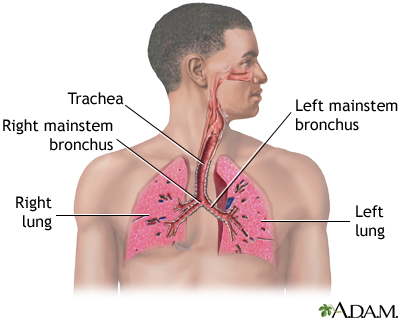Pneumomediastinum
Mediastinal emphysema
Pneumomediastinum is air in the mediastinum. The mediastinum is the space in the middle of the chest, between the lungs and around the heart.
Images

I Would Like to Learn About:
Causes
Pneumomediastinum is uncommon. The condition can be caused by injury or disease. Most often, it occurs when air leaks from any part of the lung or airways into the mediastinum.
Increased pressure in the lungs or airways may be caused by:
- Too much coughing
- Repeated bearing down to increase abdominal pressure (such as pushing during childbirth or a bowel movement)
- Sneezing
- Vomiting
It may also happen after:
- An infection in the neck or center of the chest
- Rapid rises in altitude, or scuba diving
- Tearing of the esophagus (the tube that connects the mouth and stomach)
- Tearing of the trachea (windpipe)
- Use of a breathing machine (ventilator)
- Use of inhaled recreational drugs, such as marijuana or crack cocaine
- Surgery
- Trauma to the chest
Pneumomediastinum also can occur with collapsed lung (pneumothorax) or other diseases.
Symptoms
There may be no symptoms. The condition usually causes chest pain behind the breastbone, which may spread to the neck or arms. The pain may be worse when you take a breath or swallow.
Exams and Tests
During a physical exam, your health care provider may feel small bubbles of air under the skin of the chest, arms, or neck (called subcutaneous emphysema).
A chest x-ray or CT scan of the chest may be done. This is to confirm that air is in the mediastinum, and to help diagnose a hole in the trachea or esophagus.
When examined, sometimes the person can look very puffy (swollen) in the face and eyes. This can look worse than it actually is.
Treatment
Often, no treatment is needed because the body will gradually absorb the air. Breathing high concentrations of oxygen may speed this process.
The provider may put in a chest tube if you also have a collapsed lung. You may also need treatment for the cause of the problem. A hole in the trachea or esophagus needs to be repaired with surgery.
Outlook (Prognosis)
The outlook depends on the disease or events that caused the pneumomediastinum.
Possible Complications
Air may build up and enter the space around the lungs (pleural space), causing the lung to collapse.
In rare cases, air may enter the area between the heart and the thin sac that surrounds the heart. This condition is called a pneumopericardium.
In other rare cases, so much air builds up in the middle of the chest that it pushes on the heart and the great blood vessels, so they cannot work properly.
All of these complications require urgent attention because they can be life threatening.
When to Contact a Medical Professional
Go to the emergency room or call 911 or the local emergency number if you have severe chest pain or difficulty breathing.
Related Information
Collapsed lung (pneumothorax)References
McCool FD. Diseases of the diaphragm, chest wall, pleura, and mediastinum. In: Goldman L, Cooney KA, eds. Goldman-Cecil Medicine. 27th ed. Philadelphia, PA: Elsevier; 2024:chap 86.
Vemana AP, Haider SK. Pneumomediastinum. In: Kliegman RM, St. Geme JW, Blum NJ, et al, eds. Nelson Textbook of Pediatrics. 22nd ed. Philadelphia, PA: Elsevier; 2025:chap 462.
BACK TO TOPReview Date: 8/19/2024
Reviewed By: Allen J. Blaivas, DO, Division of Pulmonary, Critical Care, and Sleep Medicine, VA New Jersey Health Care System, Clinical Assistant Professor, Rutgers New Jersey Medical School, East Orange, NJ. Review provided by VeriMed Healthcare Network. Also reviewed by David C. Dugdale, MD, Medical Director, Brenda Conaway, Editorial Director, and the A.D.A.M. Editorial team.

Health Content Provider
06/01/2025
|
A.D.A.M., Inc. is accredited by URAC, for Health Content Provider (www.urac.org). URAC's accreditation program is an independent audit to verify that A.D.A.M. follows rigorous standards of quality and accountability. A.D.A.M. is among the first to achieve this important distinction for online health information and services. Learn more about A.D.A.M.'s editorial policy, editorial process and privacy policy. A.D.A.M. is also a founding member of Hi-Ethics. This site complied with the HONcode standard for trustworthy health information from 1995 to 2022, after which HON (Health On the Net, a not-for-profit organization that promoted transparent and reliable health information online) was discontinued. |
The information provided herein should not be used during any medical emergency or for the diagnosis or treatment of any medical condition. A licensed medical professional should be consulted for diagnosis and treatment of any and all medical conditions. Links to other sites are provided for information only -- they do not constitute endorsements of those other sites. © 1997- 2025 A.D.A.M., a business unit of Ebix, Inc. Any duplication or distribution of the information contained herein is strictly prohibited.
